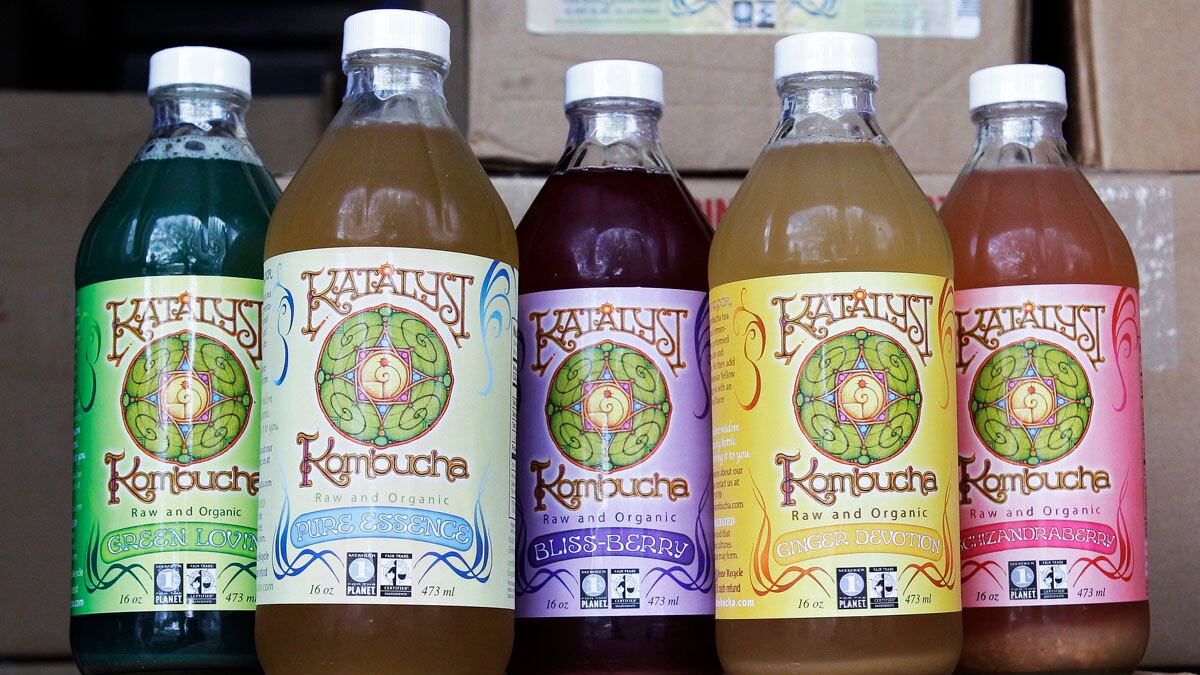It costs just a few bucks per bottle in your local supermarket and is claimed to reverse the aging process and cure everything from baldness to cancer. For pennies, it can even be brewed at home, if you don’t mind a little slime.
So who wouldn’t join Madonna, Halle Berry, Lindsay Lohan, and Gwyneth Paltrow on the kombucha bandwagon, especially now that new scientific studies appear to support all those claims? A sparkling golden fermented beverage that packs a massive antioxidant punch and looks and tastes like a cross between Champagne and vinegar, kombucha is now a $150-million-a-year industry that’s growing exponentially, despite worries about possible side effects and health risks.
Comprising acetic acid, malic acid, butyric acid, oxalic acid, lactic acid, and a teensy bit of alcohol, kombucha has been a standard refresher, alleged hangover cure, and all-around home remedy in Asia and Eastern Europe for millennia. Its origins and etymology are veiled in mystery: cha is Chinese for “tea,” but debates rage over those first two syllables. Some say kombucha was brought to Russia by Manchurian traders. Others trace it to southern China, Korea, and Japan. Some go so far as to call it ancient.
Which culture created it? When something’s being touted as the next best thing to manna, everyone wants to say, "We had it first."
“In many cases—but not all—foods that have long, rich cultural and medicinal traditions often turn out to have proven scientific benefits,” says registered dietitian Sharon Palmer, author of The Plant-Powered Diet. Still, she adds that “although celebrities bring attention to many issues of diet and nutrition, that doesn’t mean they are always correct or give the best advice.”
Kombucha was withdrawn from Whole Foods and other stores in the summer of 2010 due to concerns over its alcohol content. By that fall, it was back on the shelves.

Because the rubbery white wodge that fuels its fermentation resembles a mushroom cap, kombucha is often mistakenly called “mushroom tea.” That mat is actually a culture: in technical terms, a symbiotic colony of bacteria and yeast. Fed a steady stream of super-sweet black, green, or white tea—one cup of sugar per gallon—it will replicate indefinitely, producing ever more wodges, each of which can be reused indefinitely.
Mid-20th-century Russian and German studies credited kombucha with reducing or curing dysentery, dyspepsia, high blood pressure, gastritis, colitis, gout, kidney stones, and even cancer. Nobel Prize winner Aleksandr Solzhenitsyn credited kombucha with curative properties in his novel The Cancer Ward. After his own bout with cancer, Ronald Reagan became a fan. Celebs have followed suit ever since: Reese Witherspoon, Anna Paquin, and Orlando Bloom have been snapped clutching bottles of “booch.” Now a new wave of studies might boost sales even higher.
One cell-based study, destined for the June 2012 issue of the journal Swiss Society of Food Science and Technology’s, asserts that kombucha “has prophylactic and therapeutic properties” including antimicrobial, antibacterial, and antifungal effects. Its authors speculate that kombucha “may be very healthful” in combating yeast infections, thrush, and other forms of candidiasis.
Palmer warns that the scientific evidence on kombucha’s benefits is just in the preliminary stages. “Cell and animal studies indicate that it may have some antioxidant properties, but there’s no proof to back many of the popular claims,” she says.
A 2011 study affiliated with India’s Jadavpur University and published in Pathophysiology found that kombucha consumption effectively protects liver cells. Its authors conclude that kombucha “was found to modulate the oxidative stress-induced apoptosis in murine hepatocytes probably due to its antioxidant activity and functioning via mitochondria dependent pathways and could be beneficial against liver diseases, where oxidative stress is known to play a crucial role.”
Maybe Lindsay Lohan wouldn’t put it quite that way, but the message is clearly spreading.
“I sell every bottle of kombucha that I make, and I can hardly keep up with demand,” says Alex Hozven, co-owner of the Cultured Pickle Shop in Berkeley, Calif.
Hozven first began brewing kombucha 13 years ago, when she was nursing her son. Having given up caffeine, she had heard that kombucha produced a light buzz.
“I was interested in fermented foods anyway,” she recalls. “Here was one more to experiment with.”
Using local produce, she devised a line of seasonal luxury kombuchas such as blood orange-caraway, parsley-grapefruit, and lemon-turmeric-sunflower-greens, as well as pumpkin, celery, carrot, fennel, jalapeño pepper, turnip, and beet. They have proved wildly popular.
“My kombucha’s a lot more expensive than anything else out there,” Hozven says, “but I still sell every drop.”
The latest studies join a growing archive showing similarly positive results. A cell-based 2010 study published in the Food & Function journal cited kombucha’s capacity for combating free radicals, a type of molecule that furthers the aging process. And a cell-based 2007 study published in Food Chemistry noted the “structural modification of components in tea due to enzymes liberated by bacteria and yeast during kombucha fermentation which results in better scavenging performance on nitrogen and superoxide radicals.”
“I think that these studies are intriguing and that kombucha may very well turn out to possess some health-promoting activities,” Palmer says. “But we don’t know enough about it at this point. Even if a cell study shows antioxidant potential, that doesn’t mean that these benefits translate over to humans.
“It’s important to note the safety concerns of kombucha,” she adds. “There have been side effects reported—like stomach upsets, infections, and even deaths.”
The most frequently cited kombucha-related death occurred in April 1995, when the Centers for Disease Control, the Food and Drug Administration, and the Iowa Department of Public Health joined forces to investigate why a middle-aged Iowa woman with no history of heart problems had died of cardiac arrest. Her bloodstream contained perilously high levels of lactic acid; the CDC’s Morbidity and Mortality Weekly Report (MMWR) linked the finding with her having drunk home-brewed kombucha for two months.
While in small amounts kombucha “may not cause adverse effects in healthy persons ... the potential health risks are unknown for those with preexisting health problems or those who drink excessive quantities,” warned the MMWR. Thus, “health-care professionals should consider consumption of kombucha tea in the differential diagnosis of persons with unexplained lactic acidosis.”
A 2009 case involved hypothermia, acidosis, and renal failure in a young HIV-positive Los Angeles man “within twelve hours of kombucha tea ingestion,” the authors of a subsequent study assessing the case found. “While kombucha tea is considered a healthy elixir, the limited evidence currently available raises considerable concern that it may pose serious health risks.”
But in this era of kombucha mimosas and kombucha on tap, kombuchamania continues, fueled less by its sweet-and-sour tang than by its alleged ability to grow hair, zap zits, and cure killer diseases. Palmer views its growing popularity with caution.
“When diets are fads, they never seem to last long. But when diet advice is solid and science-based, it stands the test of time.”






